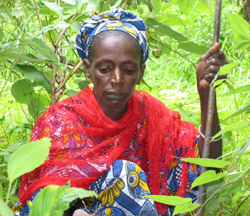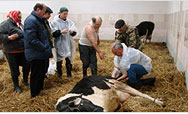You are here » Home » Telling Our Story
Case Study
Empowered villagers and committees manage their forests
Taking Charge of Natural Resources

| |
Photo: USAID/Richard Nyberg
|
|
Mampatim resident Fatoumata Dembo digs for the wild sweet root inyam, or ‘nyambi’ in the Pulaar language.
|
Challenge
Illegal tree cutting, charcoal production, land clearing and fires were rampant in Mampatim, a collective of 100 villages in
southern Senegal. Mampatim’s fertile soil and abundant forests have always been valuable resources. But over the past 10
years, the demands of a growing population brought about disorganized and sometimes abusive harvesting. Wild fruits,
game, crops and wood for furniture and charcoal were under threat, and although Senegal’s government increased the authority
of Mamaptim’s elected rural council in 1996 to oversee natural resources, residents believed state forest agents were
responsible. But with only one agent covering the entire collective, the forest service alone could not protect the area.
Initiative
USAID is helping residents create a new approach to natural resource management, based on communication and collaboration
between the state forest service and the community. With support from USAID, Mampatim residents worked with technical
specialists to learn their role in managing natural resources. Residents visited a neighboring collective and learned how its
rural council had established a forest monitoring system. USAID helped Mampatim and the forest service develop a written
code of conduct for volunteer monitors and train them to conduct patrols and deal with infringements. USAID also provided
bicycles, uniforms and motorcycles for monitors and supervisors and supplied fire-fighting equipment and training to village committees.
Results
For the first time in years, Mampatim residents have an abundance of wild fruits, syrup from trees and forage for their livestock
— a change they credit largely to Mampatim’s village surveillance committees. In 2004 the committees put out three
brush fires, conducted preventive burning on 250 hectares of forest and pasture land and reported nine cases of illegal activities.
The rural council and the forest service now coordinate forest maintenance efforts and everyone now realizes they are
working toward the same goal: to ensure that Mampatim’s precious natural resources are managed wisely.
Print-friendly version of this page (70kb - PDF)
Click here for high-res photo
Back to Top ^ | 

